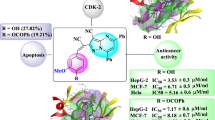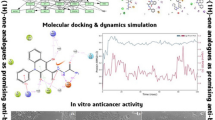Abstract
The present work reports the synthesis of 20 novel fluorine-containing quinoline and pyrimido[4,5-b]quinoline derivatives bearing a sulfonamide moiety. The new synthesized compounds were designed in compliance with the general pharmacophoric requirements for carbonic anhydrase (CA) inhibiting anticancer drugs, as this may play a role in their anticancer activity. All the newly synthesized compounds were evaluated for their in vitro anticancer activity against human breast cancer cell line (MCF7). Compounds 11 and 12 exhibited better activities than the reference drug doxorubicin (IC50 = 71.8 μM) with IC50 values of 52.6 μM and 67.3 μM, respectively. On the other hand, compounds 6, 10, and 13 showed IC50 values (71.8 μM, 69.8 μM, and 70.8 μM, respectively) comparable to that of the reference drug doxorubicin. In addition, docking of the synthesized compounds into human carbonic anhydrase isozyme II (hCA II) active site was performed in order to predict the affinity and the orientation of these compounds at the isozyme active site. Also, the most active compounds, 11 and 12, were selected and evaluated for their ability to enhance the cell killing effect of γ-radiation.













Similar content being viewed by others
References
Abbate F, Casini A, Owa T, Scozzafava A, Supuran CT (2004) Carbonic anhydrase inhibitors: E7070, a sulfonamide anticancer agents, potently inhibits cytosolic isozymes I and II, and transmembrane, tumor-associated isozyme IX. Bioorg Med Chem Lett 14:217–223
Bégué JP, Delpon DB (2006) Recent advances (1995–2005) in fluorinated pharmaceuticals based on natural products. J Fluorine Chem 127:992–1012
Boyd AE III (1988) Sulfonylurea receptors, ion channels, and fruit flies. Diabetes 37:847–850
Casini A, Scozzafava A, Mastrolorenzo A, Supuran CT (2002) Sulfonamides and sulfonylated derivatives as anticancer agents. Curr Cancer Drug Targets 2:55–75
Drews J (2000) Drug discovery: a historical perspective. Science 287:1960–1964
Ghorab MM, Noaman E, Ismail MM, Heiba HI, Ammar YA, Sayed MY (2006) Novel antitumor and radioprotective sulfonamides containing pyrrolo[2,3-d]pyrimidines. Arzneimittelforschung 56:405–413
Ghorab MM, Ragab FA, Noaman E, Heiba HI, El-Hossary EM (2007) Synthesis of some novel quinolines and pyrimido[4,5-b]quinolines bearing a sulfonamide moiety as potential anticancer and radioprotective agents. Arzneimittelforschung 57:795–803
Ghorab MM, Ragab FA, Hamed MM (2009) Design, synthesis and anticancer evaluation of novel tetrahydroquinoline derivatives containing sulfonamide moiety. Eur J Med Chem 44:4211–4217
Gopal M, Shenoy S, Doddamani LS (2003) Antitumor activity of 4-amino and 8-methyl-4-(3diethylamino propylamino)pyrimido[4′,5′:4,5]thieno (2, 3-b) quinolines. J Photochem Photobiol B 72:69–78
Ismail FMD (2002) Important fluorinated drugs in experimental and clinical use. J Fluorine Chem 118:27–33
Ismail MM, Ghorab MM, Noaman E, Ammar YA, Heiba HI, Sayed MY (2006) Novel synthesis of pyrrolo[2,3-d]pyrimidines bearing sulfonamide moieties as potential antitumor and radioprotective agents. Arzneimittelforschung 56:301–308
Kim YH, Shin KJ, Lee TG, Kim E, Lee MS, Ryu SH, Suh PG (2005) G2 arrest and apoptosis by 2-amino-N-quinoline-8-yl-benzenesulfonamide (QBS), a novel cytotoxic compound. Biochem Pharmacol 69:1333–1341
Liou JP, Wu ZY, Kuo CC, Chang CY, Lu PY, Chen CM, Hsieh HP, Chang JY (2008) Discovery of 4-amino and 4-hydroxy-1-aroylindoles as potent tubulin polymerization inhibitors. J Med Chem 51:4351–4355
Maren TH (1976) Relations between structure and biological activity of sulfonamides. Annu Rev Pharmacol Toxicol 16:309–327
Nishimura Y (2004) Rationale for chemoradiotherapy. Int J Clin Oncol 9:414–420
Pastorekova S, Parkkila S, Pastorek J, Supuran CT (2004) Carbonic anhydrases: current state of the art, therapeutic applications and future prospects. J Enzym Inhib Med Chem 19:199–229
Rostom SA (2006) Synthesis and in vitro antitumor evaluation of some indeno[1,2-c]pyrazol(in)es substituted with sulfonamide, sulfonylurea(-thiourea) pharmacophores, and some derived thiazole ring systems. Bioorg Med Chem 14:6475–6485
Skehan P, Storeng R, Scudiero D, Monks A, McMahon J, Vistica D, Warren JT, Bokesch H, Kenney S, Boyd MR (1990) New colorimetric cytotoxicity assay for anticancer-drug screening. J Natl Cancer Inst 82:1107–1112
Supuran CT, Scozzafava A (2000) Carbonic anydrase inhibitors and their therapeutic potential. Exp Opin Ther Pat 10:575–600
Supuran CT, Scozzafava A (2001) Carbonic anhydrase inhibitors. Curr Med Chem 1:61–97
Supuran CT, Scozzafava A (2007) Carbonic anhydrases as targets for medicinal chemistry. Bioorg Med Chem 15:4336–4350
Supuran CT, Scozzafava A, Casini A (2003) Carbonic anhydrase inhibitors. Med Res Rev 23:146–189
Supuran CT, Casini A, Mastrolorenzo A, Scozzafava A (2004) COX-2 selective inhibitors, carbonic anhydrase inhibition and anticancer properties of sulfonamides belonging to this class of pharmacological agents. Mini-Rev Med Chem 4:625–632
Thiry A, Ledecq M, Cecchi A, Dogne JM, Wouters J, Supuran CT, Masereel B (2006) Indanesulfonamides as carbonic anhydrase inhibitors. Toward structure-based design of selective inhibitors of the tumor-associated isozyme CA IX. J Med Chem 49:2743–2749
Thornber CW (1979) Isosterism and molecular modification in drug design. Chem Soc Rev 8:563–580
Zhao YL, Chen YL, Chang FS, Tzeng CC (2005) Synthesis and cytotoxic evaluation of certain 4-anilino-2-phenylquinoline derivatives. Eur J Med Chem 40:792–797
Author information
Authors and Affiliations
Corresponding author
Rights and permissions
About this article
Cite this article
Ghorab, M.M., Ragab, F.A., Heiba, H.I. et al. Docking study, in vitro anticancer screening and radiosensitizing evaluation of some new fluorine-containing quinoline and pyrimidoquinoline derivatives bearing a sulfonamide moiety. Med Chem Res 20, 388–400 (2011). https://doi.org/10.1007/s00044-010-9332-3
Received:
Accepted:
Published:
Issue Date:
DOI: https://doi.org/10.1007/s00044-010-9332-3




